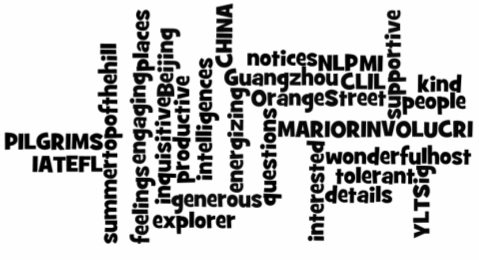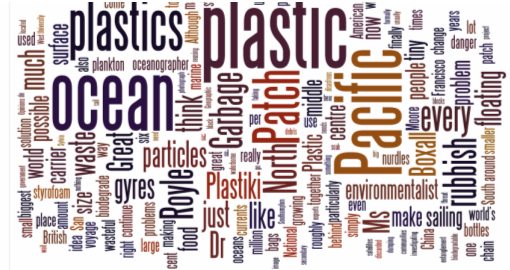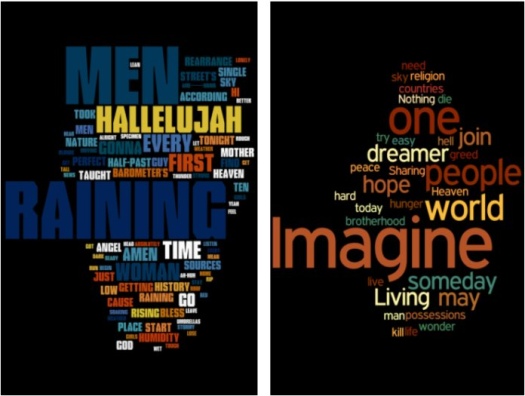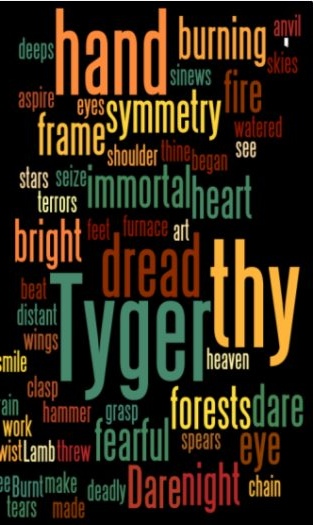Word Clouds
Hanna Kryszewska, Poland
Menu
Introduction
What is a word cloud?
Pre-teaching
Songs
Revising
HLT and other journals
Technical tips
In this issue, in one of the texts (Mario Rinvolucri) you can see the following word cloud submitted by Wendy Arnold:

At www.wordle.net, you can make friends with “Wordle” which is a nice little programme that makes “word clouds”. You paste in any authentic text, poem, song, text from the coursebook etc. Then you click a button and a lovely arrangement of words appears on the screen. The words that are more frequent in the text are more prominent than others. You can also change automatically generated colour, font and layout.
So it is a tool that treats a text of your choice as a corpus, and presents the frequency in a design and arrangement pleasing to the eye. A kind of computer generated ‘mind map’. There are many uses for it in a language class.
1. Give out a ‘word cloud’ you have prepared earlier.
2. The students decide what the text will be about.

3. Give out the headline and introduction to the article. Students decide if their
predictions were right.
The Biggest Dump in the World
As large as the USA, the Great Pacific Waste Patch is the biggest dump in the world. Ed Cumming discovers that it keeps getting bigger, and could be poisoning us all
By Ed Cumming
Published: 7:00AM GMT 16 Mar 2010
|
4. Students read the text and notice the words that appeared in the ‘word cloud’.
www.telegraph.co.uk/science/7450769/The-Biggest-Dump-in-the-World.html
5. The class can prepare their alternative ‘word cloud’ manually on the board or
poster paper.
1. Prepare a few ‘word clouds’ of well known songs. e.g.

2. Students guess the song and try to remember as much of the lyrics as possible.
They use the words in the ‘cloud’ as a prompt..
3. Each student prepares a word cloud of their favourite song.
4. Students mill around and guess each other’s songs and recall bits of the lyrics.
1. Let’s assume you have worked with the following poem:
The Tyger
Tyger! Tyger! burning bright,
In the forests of the night,
What immortal hand or eye
Could frame thy fearful symmetry?
In what distant deeps or skies
Burnt the fire in thine eyes?
On what wings dare he aspire?
What the hand dare seize the fire?
And what shoulder, and what art?
Could twist the sinews of thy heart?
And when thy heart began to beat,
What dread hand, and what dread feet?
What the hammer? What the chain?
In what furnace was thy brain?
What the anvil? What dread grasp
Dare its deadly terrors clasp?
When the stars threw down their spears,
And watered heaven with their tears,
Did he smile his work to see?
Did he who made the Lamb, make thee?
Tyger! Tyger! burning bright,
In the forests of the night,
What immortal hand or eye
Dare frame thy fearful symmetry?
William Blake
2. Use this earlier prepared ‘word cloud’ to recall the poem.

Perhaps we could use ‘word clouds’ to introduce new articles in HLT and other journals as an alternative form of an abstract. This is a preview of an article to appear in HLT soon.
How Children Learn Languages
Hanna Kryszewska, Poland
|

The ‘word cloud’ above was created on the basis of a text which is 9916 words long.
You can create ‘word clouds’ on line in the classroom. You need a computer, data projection and Internet connection.
‘Wordle’ information states the following:
The images you create with Wordle are yours to use however you like. You can print them out, or save them to the Wordle gallery to share with your friends.
However, there is a way to save them onto your computer and use in your articles, the way I have. Originally I had a problem but thanks to Jamie Keddie I solved the problem. Please view the steps to follow at:
www.youtube.com/watch?v=kQmXQINNKeo
Thank you Jamie. For more great ideas and solutions Jamie has to offer visit:
www.teflclips.com (YouTube lesson plans)
www.jamiekeddie.com (TEFL teaching ideas blog)

Please check the How to Use Technology in the Classroom course at Pilgrims website.


|